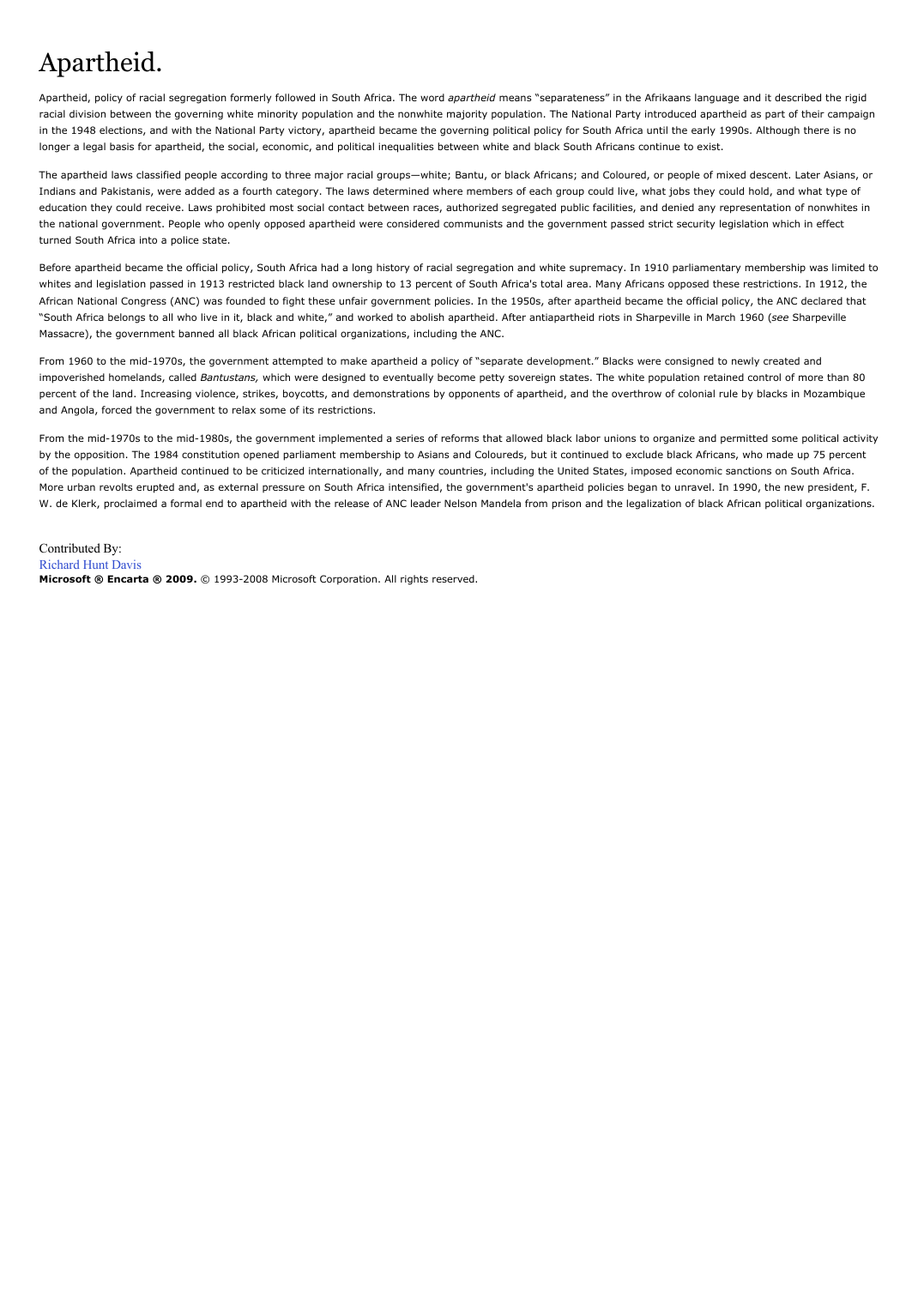Apartheid.
Publié le 18/05/2020

Extrait du document
«
Apartheid.
Apartheid , policy of racial segregation formerly followed in South Africa.
The word apartheid means “separateness” in the Afrikaans language and it described the rigid racial division between the governing white minority population and the nonwhite majority population.
The National Party introduced apartheid as part of their campaignin the 1948 elections, and with the National Party victory, apartheid became the governing political policy for South Africa until the early 1990s.
Although there is nolonger a legal basis for apartheid, the social, economic, and political inequalities between white and black South Africans continue to exist.
The apartheid laws classified people according to three major racial groups—white; Bantu, or black Africans; and Coloured, or people of mixed descent.
Later Asians, orIndians and Pakistanis, were added as a fourth category.
The laws determined where members of each group could live, what jobs they could hold, and what type ofeducation they could receive.
Laws prohibited most social contact between races, authorized segregated public facilities, and denied any representation of nonwhites inthe national government.
People who openly opposed apartheid were considered communists and the government passed strict security legislation which in effectturned South Africa into a police state.
Before apartheid became the official policy, South Africa had a long history of racial segregation and white supremacy.
In 1910 parliamentary membership was limited towhites and legislation passed in 1913 restricted black land ownership to 13 percent of South Africa's total area.
Many Africans opposed these restrictions.
In 1912, theAfrican National Congress (ANC) was founded to fight these unfair government policies.
In the 1950s, after apartheid became the official policy, the ANC declared that“South Africa belongs to all who live in it, black and white,” and worked to abolish apartheid.
After antiapartheid riots in Sharpeville in March 1960 ( see Sharpeville Massacre), the government banned all black African political organizations, including the ANC.
From 1960 to the mid-1970s, the government attempted to make apartheid a policy of “separate development.” Blacks were consigned to newly created andimpoverished homelands, called Bantustans, which were designed to eventually become petty sovereign states.
The white population retained control of more than 80 percent of the land.
Increasing violence, strikes, boycotts, and demonstrations by opponents of apartheid, and the overthrow of colonial rule by blacks in Mozambiqueand Angola, forced the government to relax some of its restrictions.
From the mid-1970s to the mid-1980s, the government implemented a series of reforms that allowed black labor unions to organize and permitted some political activityby the opposition.
The 1984 constitution opened parliament membership to Asians and Coloureds, but it continued to exclude black Africans, who made up 75 percentof the population.
Apartheid continued to be criticized internationally, and many countries, including the United States, imposed economic sanctions on South Africa.More urban revolts erupted and, as external pressure on South Africa intensified, the government's apartheid policies began to unravel.
In 1990, the new president, F.W.
de Klerk, proclaimed a formal end to apartheid with the release of ANC leader Nelson Mandela from prison and the legalization of black African political organizations.
Contributed By:Richard Hunt DavisMicrosoft ® Encarta ® 2009. © 1993-2008 Microsoft Corporation.
All rights reserved..
»
↓↓↓ APERÇU DU DOCUMENT ↓↓↓
Liens utiles
- Diaporama Apartheid
- Nelson Mandela Colonie britannique, l'Afrique du Sud connut depuis la victoire du partinationaliste en 1948, un programme de ségrégation implacable, appelé" apartheid ".
- Qui fut le chef du gouvernement sud-africain qui instaura l'apartheid:A.
- APARTHEID
- Grand oral du bac : L'apartheid


